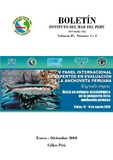Por favor, use este identificador para citar o enlazar este ítem:
https://hdl.handle.net/20.500.12958/1103Registro completo de metadatos
| Campo DC | Valor | Lengua/Idioma |
|---|---|---|
| dc.contributor.author | Bertrand, Sophie | - |
| dc.contributor.author | Silva Alva, Jaime | - |
| dc.contributor.author | Goya Sueyoshi, Elisa | - |
| dc.date.accessioned | 2012-11-16T12:38:49Z | - |
| dc.date.available | 2012-11-16T12:38:49Z | - |
| dc.date.issued | 2010-12 | - |
| dc.identifier.issn | 0378-7699 | - |
| dc.identifier.uri | https://hdl.handle.net/20.500.12958/1103 | - |
| dc.description | Boletín IMARPE vol. 25, nº 1-2, 2010; p. 39-44 | es_ES |
| dc.description.abstract | Con el examen conjunto de datos de seguimiento satelital de la flota pesquera y de marcaje electrónico de aves marinas, se analizan las interacciones entre la actividad pesquera y el forrajeo de las aves en periodo de reproducción. Se evidencia que las aves pueden mitigar la competencia con la pesca hasta cierto punto, forrajeando más lejos o quedándose más tiempo en el mar. Sin embargo, las aves en reproducción enfrentan a la vez un alto requerimiento energético para alimentar los pichones, y viajes de forrajeo limitados en distancia y tiempo por la necesidad de atender el nido. Para optimizar el éxito reproductivo de las aves marinas se recomienda: (1) Estimar, con la ayuda de modelos ecotróficos, qué cantidad de anchoveta sería conveniente ‘reservar’ para la alimentación de las aves; (2) Establecer zonas temporalmente cerradas a la pesca, alrededor de las principales colonias en los meses de reproducción de las aves. Los rangos máximos de forrajeo observados en guanayes y piqueros sugieren un radio de 50 a 100 km alrededor de las colonias, lo cual permitiría asegurar el forrajeo de estas especies en periodo de reproducción y así favorecer la sostenibilidad de sus poblaciones. | es_ES |
| dc.description.abstract | ABSTRACT: Using data from Vessel Monitoring System (VMS) and seabird electronic tracking, we analyze the interactions between the fishing activity and the foraging of breeding seabirds. We show that seabirds are able to cope with the competition with the fishery to a certain extent, foraging farther or longer. Still, breeding seabirds face at the same time high energetic demands to feed the chicks and limited foraging ranges in time and space because of the need to attend the nest. To optimize seabird breeding success, we recommend: (1) to estimate with trophic models, the adequate quantity of anchovy to reserve for seabirds; (2) to establish temporary closed areas to fishing around main breeding colonies. Maximum foraging ranges observed for guanay and booby suggest a radius of 50 to 100 km for those closed areas that would secure the foraging of those species when breeding, and then favor their population sustainability | - |
| dc.language.iso | spa | es_ES |
| dc.publisher | Instituto del Mar del Perú | es_ES |
| dc.relation.ispartofseries | Boletín IMARPE vol. 25, nº 1-2, 2010 | - |
| dc.rights | info:eu-repo/semantics/openAccess | - |
| dc.rights.uri | https://creativecommons.org/licenses/by/4.0/ | - |
| dc.source | Instituto del Mar del Perú - IMARPE | - |
| dc.source.uri | Repositorio Digital IMARPE | - |
| dc.subject | Pesca | es_ES |
| dc.subject | Aves Marinas | es_ES |
| dc.title | Pescadores y aves marinas compitiendo por el mismo recurso: estrategias de forrajeo, interacciones y consecuencias | es_ES |
| dc.title.alternative | Fishers and seabirds competing for the same fish: Foraging strategies, interactions and consequences | es_ES |
| dc.type | info:eu-repo/semantics/article | es_ES |
| Aparece en las colecciones: | Boletín 25(1-2), 2010 | |
Ficheros en este ítem:
| Fichero | Descripción | Tamaño | Formato | |
|---|---|---|---|---|
| BOL 25(1-2)-5.pdf | 1,12 MB | Adobe PDF |  Visualizar/Abrir |
Este ítem está sujeto a una licencia Creative Commons Licencia Creative Commons

